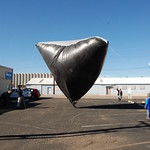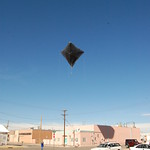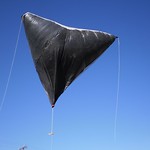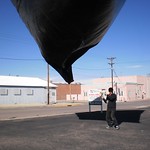MEMBERS of a Warminster astronomy club have been left devastated after parts of a weather balloon which they launched to the edge of space were damaged and stolen by thieves when it landed in Guildford.
The GoPro camera and its SD card, which had captured footage from the out of this world flight, was stolen from its polystyrene casing soon after the balloon landed with costs to replace and repair parts expected to exceed £800.
Organiser of the launch and chairman of StarQuest Astronomy Club, Pete Lee, said: “It landed in a school playing field in Guildford and we noticed that it had been moved to the side and we thought that maybe a match was going on and it was in the way.
“It took us about 20 minutes to get to the school from Farnham where we thought it was going to land, but we went around the back and there it was smashed open.
“You could see the boot imprints in it from where someone had kicked it open. I was with my son and daughter and we were all just totally and utterly gutted.
“We’d spent months planning for it and it just made the rest of it seem like a waste of time.”
After getting permission from the Civil Aviation Authority and sponsorship from local companies Olive Training and Case European Channel Sales over several months, the ill-fated launch took place at the start of the month from Warminster with the balloon travelling more than 80 miles in its two hour and 15 minute journey.
.
PROMOTED STORIES
•
Rachel Riley Responds After Countdown Controversy (Entertainment Daily)
•
David Walliams left ‘devastated’ after split from wife Lara Stone (Entertainment Daily)
•
Python Eats A Porcupine Whole, Then The Unexpected Happens (LolBoom)
•
The crazy family who lived with the lion and their tragic end (WPLOL)
•
A Grandpa Left A Trunk Behind For His Family – What’s Inside Is Incredible (Viral Nova)
•
The PGA’s 31 Most Surprising Wives And Girlfriends (AllRookie)
Recommended by
.
During that time, data from a black box found that the weather balloon reached an altitude of 80,000ft and that the temperature outside plummeted to -50C.
Mr Lee added: “Everything was being put on the SD card which was the most valuable bit and so we’ve got no pictures. I think everyone is gutted.
“We’ve told the police and we feel that the school has got CCTV so hopefully it captured who did this but even if we do find them they might have wiped the SD card.
“It hasn’t put us off doing it again though, my son wants to have another go. We’ve got to get some pictures from up there.”















